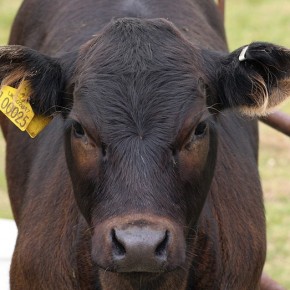The US Department of Agriculture confirmed the nation’s fourth case of mad cow disease on Apr. 24.
In a statement, U.S. Agriculture Secretary Tom Vilsack reassured Americans that the food supply is safe.
“The beef and dairy in the American food supply is safe and USDA remains confident in the health of U.S. cattle. The systems and safeguards in place to protect animal and human health worked as planned to identify this case quickly.”
The USDA, however, is now searching for offspring of the infected cow, citing evidence that mad cow disease can be passed from mother to calf. They are also looking for cows that were in the same herd as the infected cow when it was younger.
People can contract a deadly form of the disease by eating infected meat. Studies, however, show that it cannot be caught by drinking milk.
The cow was identified in a rendering facility as part of the government’s ongoing surveillance of mad cow disease, also known as bovine spongiform encephalopathy (BSE). Each year, the USDA tests 40,000 animals from farms, slaughterhouses, livestock markets, etc., focusing on high-risk animals. The program is designed to detect very low levels of mad cow disease in the country’s cattle population.
On Tuesday, the government highlighted the reasons that Americans are safe from BSE:
- The infected cow, which was destroyed after testing, was not destined for the human food supply. Cows sent to a rendering facility, like the one in California, are typically used for pet food or industrial purposes.
- The infected cow was a dairy cow, and mad cow disease cannot be transmitted through milk
- This case involved an atypical—rare—form of BSE, caused by a spontaneous mutation, rather than by cows eating infected meat.
In a recording on Wednesday, however, the USDA raised the issue of whether that cow was infected by feed. The government’s investigation is ongoing.
Mad cow disease occurs rarely, and affects the brain and spinal tissue of infected cows. Unlike other infectious diseases caused by bacteria or viruses, mad cow disease is caused by unusual proteins, called prions. These proteins, which occur naturally in the brain, can spontaneously mutate to become harmful, and damage the central nervous system of the infected cow.
The disease can spread when cattle eat meat-and-bone meal made from infected cattle. This type of transmission was drastically reduced when the government enacted feed bans that prohibited potentially infectious tissues from being used as cattle feed.
Researchers think that the first mad cow infections occurred in the 1970’s, with the first case identified in 1986. At the peak of the outbreak, 1,000 new cases were reported each week in the UK. After strict government guidelines and surveillance programs were developed, this dropped to 11 cases in 2010.
Through 2010, 22 cases have been identified in North America. Three of those were in the US—Washington State in 2003, Texas in 2005, and Alabama in 2006.
People who eat meat from infected cattle can contract a form of the disease—called variant Creutzfeldt-Jakob (vCJD) disease. This is a progressive neurological disorder, with symptoms that include dementia, muscle stiffness or twitching, and unusual sensory symptoms. The disease last for 13 to 14 months, and is always fatal.
Fewer than 200 people have had vCJD worldwide since it was first reported in 1996. During the 1980’s and 1990’s, 150 people in the UK died as a result of the brain-wasting disease. Three cases of vCJD have been reported in the US, with all of those people likely infected in the UK or Saudi Arabia. No cases of people being infected in the US have been reported.
_________
Photo: Some rights reserved by foxypar4




Unlike the US Canada does not have a shoot, shovel and shut-up polciy about mad cow cases. Seeing what Canada has been put with in after being very forward about any cases that are even remotely suspected, why would the US want to mention any cases that they undoubtedly DO HAVE! Where do you think the feed came from that made the cows mad?? and why would you even thinnk for a minute this feed was only sold in Canada?? Think folks, think! There is no such thing as a US or Canadian cow, as they have been crossing the borders for over one hundred years for breeding, slaughter, genetic variations you name it. So shut up about keeping Canadian beef out of the US, or if that doesn’t work for you may be Canada should stop importing produce from the US e-coli is as deadly as mad cow! We all want to support our local farmers and buy American or buy Canadian, but you are not doing your local farmers any favours if everyone does this, since export and import is likely their biggest money maker as it is with any business. Free trade was a US idea, and so was NAFTA, so live with it!